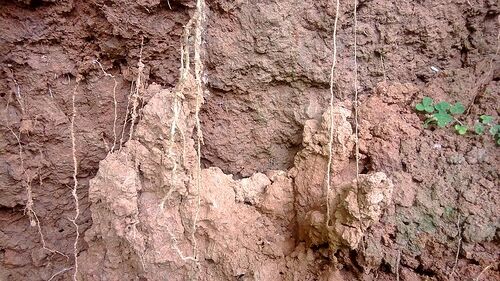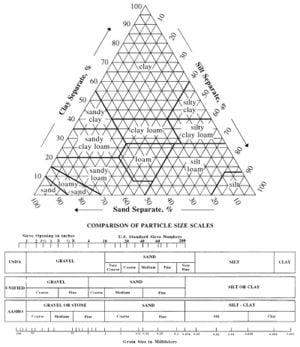(Insertion of image) |
|||
| Line 11: | Line 11: | ||
== Clay soils == | == Clay soils == | ||
[[Image:SoilTextureTriangle.jpg|right|300px]] | |||
Clay soils with fine textures can make gardening a challenge. Dry clay soil, lacking in moisture, becomes hard or compacted and may produce lumps.<ref name="Oregon">http://extension.oregonstate.edu/gardening/how-improve-clay-soil</ref> At the other extreme, a wet clay soil turns sticky and like dough without flour, is hard to work with.<ref name="Oregon" /> | Clay soils with fine textures can make gardening a challenge. Dry clay soil, lacking in moisture, becomes hard or compacted and may produce lumps.<ref name="Oregon">http://extension.oregonstate.edu/gardening/how-improve-clay-soil</ref> At the other extreme, a wet clay soil turns sticky and like dough without flour, is hard to work with.<ref name="Oregon" /> | ||
Revision as of 01:43, 18 April 2016

Clay is fine-grained material which is found in rock or soil and consists of either one or a combination of clay minerals, such as hydrated aluminium silicate, quartz and organic elements.[1] Clay is found in soils, sedimentary rocks and geological deposits.
Clay varies in colour, depending on what the soil content is. The typical range of clay colours includes strong red, orange-red, white, grey and brown.
One of clay's features is its plastic nature when moist that changes to a hard material when the moisture is removed through drying or firing in a kiln.
Uses of clay
Clay is used for human activities and products such as making pottery, ceramics, bricks, paints, cement, tiles and containers for food and carrying.
Clay soils

Clay soils with fine textures can make gardening a challenge. Dry clay soil, lacking in moisture, becomes hard or compacted and may produce lumps.[2] At the other extreme, a wet clay soil turns sticky and like dough without flour, is hard to work with.[2]
Plants can form shallow root systems with compacted clay soils, which can increase their susceptibility to drought stress.[3]
Improving clay soils
There are various approaches to improving clay soils. Here are some of them:
- Mix organic material through the clay soil.[2] The organic material can include rotted compost, decomposed animal manure, bark, sawdust, peat moss and leaf mould.[2][3] Add 5 to 7.5cm (2 to 3 inches) of organic material to the soil and spread it. Then dig it in, or use a fork or rototiller to push the organic material through the soil to a depth around 15 to 17.5cm (6 to 7 inches).[2] Repeat this process once a year, during either spring or autumn (fall).[3]
- Add sand to clay soil that has already been improved with organic material. Add 5cm (2 inches) of organic material, then add around 5cm (2 inches) of sand to increase the quality of the clay soil.[2]